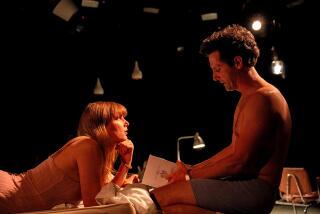Redgrave’s seance of ‘Magical Thinking’
NEW YORK — No, that’s not Joan Didion onstage recounting the harrowing period in which she suffered the back-to-back losses of her husband, writer John Gregory Dunne, and daughter, Quintana Roo Dunne Michael. That’s Vanessa Redgrave, the statuesque English actress who stands almost a foot taller than the iconic California-born author whose brilliantly idiosyncratic writing has provided one of the most reliable barometers of our sociopolitical weather since the late 1960s.
Amid much highbrow chatter, “The Year of Magical Thinking” opened Thursday at the Booth Theatre in a production that was adapted by Didion from her bestselling book and directed by British playwright David Hare. It’s hardly your typical Broadway fare, with its static talking-essay form and grim public exposure of a recent private bereavement. On paper it shouldn’t work. And for many it won’t. There are flaws in the conception and execution of the piece, and Redgrave’s otherworldly performance is bound to have an army of detractors.
But this dramatic meditation on what most of us would rather not intimately consider -- mortality as a personal fact -- is remarkable for its ruthless concentration and intelligence. Intermittently frustrating as a theatrical experience, it slowly but inevitably crescendos in moments that are shattering in their naked candor.
When word got around that a Broadway version of Didion’s memoir was in the offing, the two main questions were how and who. How do you adapt to the stage an extended autobiographical expose on the time-warping, place-shifting illogic of grief? And who will play one of the most glamorous figures in contemporary American letters, a writer who has fashioned a persona every bit as intriguing as her diamond-sharp prose?
Let’s table the discussion of the adaptation for now (noting only that it has been transformed into a one-person show) and move directly to the issue of casting. After reading “Magical Thinking,” I conducted my own hypothetical search for the star. Actresses sprang readily to mind only to be dismissed: Lee Grant (too old), Holly Hunter (too young), Linda Hunt (too Linda Huntish). If there was a dead ringer for Didion out there, the name wasn’t on any Rolodex of reputable actors I could lay my hands on.
Still, Redgrave seemed an almost defiantly implausible choice. Beyond the physical disparities, the two women come from vastly different milieus (one of left-leaning London drawing rooms, the other of Malibu sunsets and Upper East Side literati). Clearly, the only way to approach this performance is as an act of interpretation rather than impersonation.
This requires a major adjustment as you try to accept an accent that’s neither American nor British but some unplaceable amalgamation, a gangly, sturdy physique for a diminutive, frail one and a presence that’s more flamboyantly vulnerable than neurotically self-effacing. I resisted mightily at first but eventually made the leap, recognizing that the production wasn’t intended to be an illustration of the book. Think of it instead as a parallel offering that, like a lasting work of literary criticism, establishes a life of its own.
Didion, Hare and Redgrave have approached their task with a stark Beckettian determination. Stillness rules a set marked by a solitary wooden deck chair and hanging canvases of abstract patterns in muted colors that change with falling dropcloths. Nothing extraneous is allowed to distract from the ensuing trance-like contemplation.
A vision of white and gray, with her hair pulled back to reveal a pair of blue eyes that stare out with an oceanic intensity, Redgrave resembles a mythological figure who has traveled to a place of total darkness and filed a report for our collective enlightenment.
“This happened on December 30, 2003,” she says, naming the date when Didion’s husband died of a heart attack while seated in the couple’s New York apartment with a second pre-dinner drink. “That may seem a while ago, but it won’t when it happens to you. And it will happen to you. The details will be different, but it will happen to you. That’s what I’m here to tell you.”
What happened was this: Didion and Dunne had returned home from visiting their daughter, who was lying in a coma in a hospital after a case of flu had developed into pneumonia and then septic shock. They were going through their usual cozy evening ritual when Dunne collapsed. An ambulance was called to no avail. Throughout the year of mourning that followed, Didion was called on to care for her daughter, who suffered a series of medical emergencies that culminated in her death on Aug. 26, 2005, shortly before the memoir was published.
A 71-year-old man with a history of heart trouble who dies of cardiac arrest shouldn’t come as a complete astonishment. Yet Didion reminds us that it can seem that way if, lucky as her family had been until that fateful December, death was always something that happened to other people. The successful married couple had drawn an imaginary circle around their life together. They had their evening cocktails and their fireplace and their compassionate indulgence of each other’s writerly insecurities to keep them feeling safe. They had each other, not just living but working side by side, in an unusually symbiotic arrangement that lasted nearly 40 years.
“Life changes fast. Life changes in the instant. You sit down to dinner and life as you know it ends. The question of self-pity.” These are the first words that Didion writes after Dunne’s death. They’re not her best sentences. They’re a faint echo of Chekhov’s oft-quoted remark, “People are sitting at a table having dinner, that’s all, but at the same time their happiness is being created, or their lives are being torn apart.” But Didion isn’t trying to impress us here with her lyrical gifts. She’s documenting a nightmare of multiple losses with her characteristic precision and analytic scrutiny.
Her customary method is that of a lay anthropologist who doesn’t stint on the legwork. She records her own curiously superstitious behavior, the strange insistence that if she only narrows her focus and does exactly what’s required of her, perhaps she can somehow undo the permanence of her husband’s absence. She refuses to get rid of his clothes in case he shows up and needs them again. She avoids locales that will swamp her with memories confirming that he’s out of reach. She consults medical textbooks to find out what happened to him and her daughter, and psychoanalytic journals to find out what’s going on with her. She opens herself up to withering self-examination. She synthesizes her material.
“Grief turns out to be a place none of us know until we reach it,” Redgrave as Didion reads from the memoir toward the end. “We might expect to be prostrate, inconsolable, crazy with loss. We do not expect to be literally crazy.”
Didion is no longer crazy. She has done something noble, not exploitative, as has sometimes been whispered -- she has set her tough mind against the crushing intractability of existence and, knowing that she hasn’t a chance, still manages to hold her intellectual ground.
The adaptation could be better shaped. Theater demands more structural discipline than a first-person essay. And the production’s pitilessly Spartan aesthetic makes you resentful of any rambling.
Distractingly cast against type though she is, Redgrave honors this journey not by mimicking it but by processing it through her own sublimely empathic instrument. With palms occasionally outstretched as though she were holding a seance, she channels a saga that belongs to more than just one inimitable writer.
No one would ever mistake the two women, but near the end, there was a convergence that seemed to qualify as a genuine instance of magical theater.
More to Read
The biggest entertainment stories
Get our big stories about Hollywood, film, television, music, arts, culture and more right in your inbox as soon as they publish.
You may occasionally receive promotional content from the Los Angeles Times.











